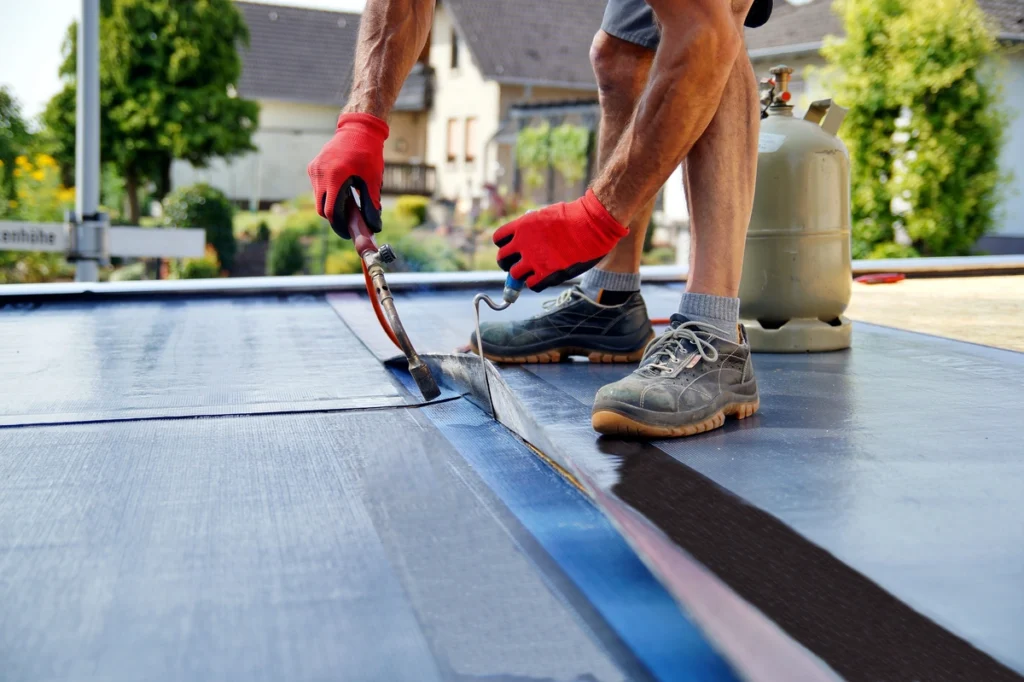Flat roofs, while not as common as sloped roofs, offer unique advantages and challenges for homeowners. Whether you’re considering a replacement due to wear and tear or seeking an upgrade for aesthetic or functional reasons, understanding the options available is crucial.
In this comprehensive guide, we’ll delve into:
- The differences between flat and sloped roofs
- Signs indicating the need for replacement
- Various materials to consider
- Costs involved
- Style considerations
- Essential maintenance practices to prolong the life of your flat roof
Keep reading to understand all of your flat roof replacement options!
Flat vs. Sloped Roofs
Flat roofs and sloped roofs serve different architectural purposes and present distinct advantages and challenges.
Flat Roofs:
Flat roofs have a horizontal or nearly horizontal surface, typically found in modern and contemporary architecture. They offer a sleek, minimalist appearance and can provide additional usable space, such as rooftop gardens or outdoor living areas. However, they require proper drainage systems to prevent water pooling, and improper installation or maintenance can lead to leaks and other issues.
Sloped Roofs:
Sloped roofs have a pitched angle, allowing water and debris to naturally drain off the surface. They are more common in traditional home designs and offer better protection against water damage. However, sloped roofs may require more materials and labor for installation and maintenance.
Signs You Need to Replace Your Flat Roof

Knowing when it’s time to replace your flat roof can prevent costly damage to your home’s interior and structure. Look out for these warning signs:
- Persistent Leaks: Water stains on ceilings or walls, or dampness in the attic, indicate roof leaks that may necessitate replacement.
- Membrane Damage: Cracks, blisters, or tears in the roofing membrane compromise its integrity and waterproofing capabilities.
- Ponding Water: Standing water on the roof for more than 48 hours indicates poor drainage and can lead to structural damage and leaks.
- Age: Flat roofs typically last 15-30 years, depending on the material used and maintenance practices. If your roof is nearing the end of its lifespan, replacement may be necessary.
- Increased Energy Bills: A deteriorating roof may allow heat or cold air to escape, leading to higher energy costs.
5 Different Flat Roof Materials
Several materials are commonly used for flat roof replacement, each with its own advantages and considerations:
1) Built-Up Roofing (BUR):
Built-up roofing, also known as tar and gravel roofing, is one of the oldest and most traditional flat roofing systems. It consists of multiple layers of bitumen (asphalt or coal tar) alternated with reinforcing fabrics such as fiberglass or polyester. These layers are typically applied hot and topped with a layer of gravel or mineral granules for UV protection and durability.
➕ Advantages:
- Durability: Built-up roofing systems are known for their longevity, with lifespans ranging from 20 to 30 years when properly maintained.
- Weather Resistance: The multiple layers provide excellent protection against weather elements, including UV rays, wind, and precipitation.
- Fire Resistance: The gravel or mineral surface acts as a fire retardant, making BUR systems suitable for fire-prone areas.
🤔 Considerations:
- Weight: Built-up roofing systems are heavy, requiring adequate structural support. Ensure your building’s structure can withstand the added weight before installation.
- Installation Complexity: BUR installation involves heating and applying layers of bitumen, which requires skilled labor and specialized equipment.
- Maintenance: While durable, built-up roofs may require periodic maintenance, including gravel replenishment and patching of surface cracks or leaks.
2) Modified Bitumen:
Modified bitumen roofing is a variation of traditional asphalt roofing, incorporating modifiers such as polymers (e.g., styrene-butadiene-styrene or SBS) to enhance flexibility, elongation, and overall performance. Modified bitumen membranes are typically installed in multiple plies or as a single-ply system with self-adhesive or heat-welded seams.
➕ Advantages:
- Flexibility: Modified bitumen membranes can accommodate building movement and temperature fluctuations without cracking or splitting.
- Ease of Installation: The membranes can be torch-applied, cold-applied, or self-adhered, offering installation flexibility and efficiency.
- Weather Resistance: Modified bitumen roofs exhibit excellent resistance to UV radiation, thermal cycling, and impact damage.
🤔 Considerations:
- Seam Integrity: Proper installation and sealing of seams are critical to prevent water infiltration and ensure long-term performance.
- Maintenance: Regular inspections and maintenance are necessary to detect and address any signs of membrane damage, such as punctures or blisters.
- Environmental Impact: Some modified bitumen products may contain volatile organic compounds (VOCs), so consider environmentally friendly options if sustainability is a concern.
3) EPDM (Ethylene Propylene Diene Terpolymer):
EPDM roofing membranes are made of synthetic rubber derived from ethylene, propylene, and diene monomers. These single-ply membranes are available in large rolls and are either mechanically fastened, fully adhered, or ballasted with gravel or pavers.
➕ Advantages:
- Durability: EPDM membranes are highly resistant to weathering, ozone, and UV exposure, with lifespans of 30 years or more.
- Low Maintenance: EPDM roofs require minimal maintenance and are resistant to common roofing issues such as tears, punctures, and shrinkage.
- Cost-Effectiveness: EPDM roofing systems offer excellent value for money, with competitive installation costs and long-term durability.
🤔 Considerations:
- Seam Vulnerability: Although EPDM membranes are durable, seams can be vulnerable to separation over time, especially if improperly installed or maintained.
- Susceptibility to Oils and Solvents: EPDM is sensitive to contact with oils, solvents, and certain chemicals, so avoid prolonged exposure to these substances.
- Thermal Expansion and Contraction: EPDM roofs may experience thermal movement, so ensure proper allowance for expansion and contraction during installation.
4) PVC (Polyvinyl Chloride):
PVC roofing membranes are made of thermoplastic materials containing polyvinyl chloride and plasticizers. These single-ply membranes are heat-welded at seams to form a watertight barrier.
➕ Advantages:
- Chemical Resistance: PVC membranes are highly resistant to chemicals, grease, oils, and microbial growth, making them suitable for commercial and industrial applications.
- Energy Efficiency: PVC roofs are available in reflective white or light-colored options, reducing heat absorption and lowering cooling costs.
- Longevity: PVC membranes have a proven track record of durability and can last 20-30 years or more with proper maintenance.
🤔 Considerations:
- Cost: PVC roofing systems may have higher upfront costs compared to other materials, but their long lifespan and energy-saving benefits contribute to overall cost-effectiveness.
- Environmental Impact: While PVC membranes are recyclable, their production process and potential for chemical emissions during installation raise environmental concerns. Look for PVC products with low VOC content and environmentally friendly manufacturing practices.
- Installation Skills: Proper installation of PVC membranes requires skilled labor and specialized welding equipment to ensure watertight seams and long-term performance.
5) TPO (Thermoplastic Olefin):
TPO roofing membranes are made of thermoplastic materials containing a blend of polypropylene and ethylene-propylene rubber. These single-ply membranes are heat-welded at seams to form a seamless and watertight barrier.
➕ Advantages:
- Energy Efficiency: TPO membranes are available in reflective white or light-colored options, offering excellent solar reflectance and thermal emittance to reduce cooling costs.
- Durability: TPO roofs are highly resistant to UV radiation, ozone exposure, and punctures, with lifespans of 20-30 years or more.
- Cost-Effectiveness: TPO roofing systems offer competitive installation costs and long-term durability, making them a popular choice for commercial and residential applications.
🤔 Considerations:
- Seam Strength: Proper installation and welding of seams are crucial to prevent seam failure and water infiltration. Insist on experienced contractors with a proven track record of TPO installation.
- Thickness Variation: TPO membranes are available in different thicknesses, with thicker membranes offering greater durability and puncture resistance. Consider your specific performance requirements when selecting membrane thickness.
Average Cost of Replacing Your Flat Roof
The cost of flat roof replacement varies depending on factors such as the size of the roof, choice of material, labor costs, and additional features like insulation or drainage systems. On average, homeowners can expect to pay between $5,000 to $15,000 for a basic replacement, with prices increasing for larger roofs or premium materials.
Choosing the Right Style for You
When selecting a replacement flat roof, consider both functional and aesthetic factors:
- Climate: Choose materials that offer adequate insulation and weather resistance for your climate.
- Budget: Balance your desired features with your budget constraints to find the best value for your investment.
- Energy Efficiency: Opt for materials with high solar reflectance and thermal emittance to reduce energy consumption and costs.
- Maintenance Requirements: Consider the long-term maintenance needs of different materials and choose accordingly.
- Architectural Style: Select a roof style that complements the overall design of your home and enhances its curb appeal.
How to Maintain Your Flat Roof
Regular maintenance is essential for extending the lifespan of your flat roof and preventing costly repairs. Here are some maintenance tips:
Inspect the Roof:
Regularly check for signs of damage, such as cracks, tears, or ponding water.
Clean Gutters and Drains:
Clear debris from gutters and drains to ensure proper water drainage and prevent clogs.
Trim Overhanging Branches:
Remove branches that could fall onto the roof and cause damage during storms or high winds.
Repair Damage Promptly:
Address any issues promptly to prevent further deterioration and water infiltration.
Schedule Professional Inspections:
Hire a roofing contractor for annual inspections to identify and address potential problems before they escalate.
Learn More About Flat Roofing Materials

Replacing a flat roof is a significant investment that requires careful consideration of materials, costs, and maintenance requirements. By understanding the differences between flat and sloped roofs, recognizing signs that replacement is necessary, exploring various materials and styles, estimating costs, and implementing proper maintenance practices, homeowners can ensure their flat roofs provide reliable protection and enhance the value of their homes for years to come.
Ready to get started? Contact G. Cannon Roofing today to pick the right roofing material for your commercial buildings.






